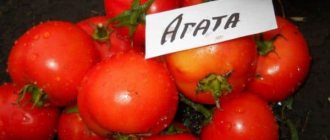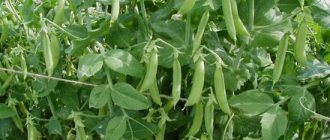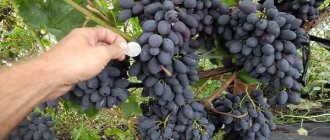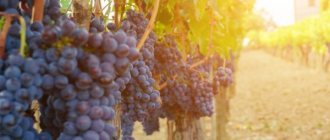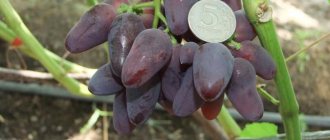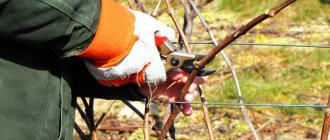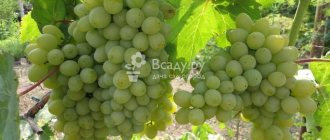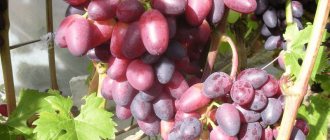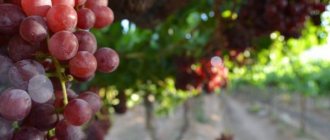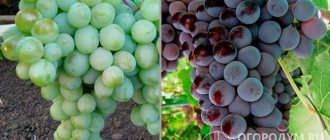Fruits and berries » Grapes
0
942
Article rating
Kira Stoletova
One of the representatives of productive crops is the Favor grape. It has excellent preservation of fruits and a pleasant sweet taste, and shows high resistance during transportation.
Grape variety Favor
Agrobiological description of the variety
The vine variety "Favor" is characterized by great growth vigor. The ripening of shoots occurs by September-October by 80-85%. Pruning is preferably medium and long. Bushes are not prone to overload.
The yield reaches 25 kilograms of berries per bush. Harvesting and technical ripeness of this hybrid occurs on day 120-130, that is, around the beginning of September.
"Favor" can withstand short-term frosts down to -23 degrees in winter. It is advisable to cover the vine of this variety in regions where winter temperatures are below this limit.
Fruit characteristics
Berries are not afraid of excess moisture. Cracking occurs extremely rarely in the most unfavorable years. Favor is not affected by wasps.
The clusters are very beautiful, loose or moderately dense with long branches, voluminous, elongated. They can reach 35-40 centimeters in length and weigh about one kilogram.
The berries hang freely in them and do not crush each other, and are covered with a thin spring. Their color is pink-red, but when hanging on the bushes for a long time it turns purple. The grain of this variety is elongated and almond-shaped. The length of the grain is about 26-30 and the width is 22-25 millimeters. The weight of the berries reaches 10-12 grams.
Taste and product characteristics
The taste of the Favor variety is very good. It does not gain sugar very quickly, but at the same time the balance of acids in the berries is such that even at the beginning of coloring the berries already have a pleasant taste and do not become sour. And further coloring of the berries only improves its taste.
Important ! The main feature of Favor is its ability to be stored for long periods of time. Even under normal conditions, the variety can last up to 3-4 months, and in refrigerators the shelf life can be even longer.
The hybrid form “Favor” tolerates transportation very well, due to the fact that the berries adhere tightly to the ridges and are not subject to cracking.
Protective features and frost resistance of Favor
In order for grapes to bear fruit normally, one bush should not have more than 30 eyes. Favor has good resistance to cold; it can withstand frosts down to -23° without additional insulation (although in winter you can make a bedding of hay). Favor has high disease resistance, which reaches a score of 3 points. Despite this, the bush is susceptible to some diseases from viruses and pests. Favor's diseases are infectious and non-infectious. It is important to start treatment in a timely manner, otherwise the fruitfulness will be reduced to half, or the entire harvest will be lost.
Bunches of grapes Favor
Today there are many agricultural techniques that help rid grapes of diseases. Favor requires rejuvenating pruning of branches and climbing vines that interfere with the bush - this is important for obtaining a harvest. You can use poisons, but it is better to refrain from strong chemicals, otherwise it will affect the quality of the crop and it will become toxic.
Description of the most dangerous diseases:
- White or gray rot. It appears as a dark coating on the leaves. If the problem is not identified in time, it damages the grafting site, causing the entire plant to die.
- Oidium. It can be identified by underdeveloped berries, although often the disease does not make itself felt until it simultaneously causes powdery mildew.
- Anthracnose affects any part of the grapes: brown spots appear on leaves, berries or shoots.
- Mildew attacks all green tissues, producing light-colored oily marks. It is the most common grape disease.
Timely identification and treatment of grape diseases will prevent the death of the plant. In turn, Favor is immune to peas, which is a strong plus. The advantage of Favor is that wasps have no interest in grapes. But birds like it, so the growing area needs to be covered with a net containing small honeycombs. You can also close the bunches in mesh bags if there are chickens on the territory. Since nutrients are distributed evenly throughout the plant, for prevention it is important to trim off excess grapes so as not to overload the grapes (this can damage the harvest).
Preventing grape diseases
The hybrid has good immunity to various diseases. Experts rate it at 3 points. Still, the grapevine can be susceptible to certain diseases. Hybrid diseases can be different - infections, or without the influence of viruses - non-infectious. It is necessary to carry out treatment on time, otherwise the yield will drop to half, or may disappear completely.
There are many different agrotechnical preventive measures that help protect the plant from diseases. In addition, grapes need rejuvenating removal of shoots of branches or vines that are not needed by the bush. This will help you get a good harvest later. Theoretically, it is possible to use poison for these purposes, but this is very dangerous and it is better not to do this - the berries can become toxic.
List of the most unpleasant grape diseases:
- Gray rot. It appears as a dark coating on the leaves. If the problem is recognized too late, it can damage the grafting site, after which the entire bush dies.
- Oidium. It can be recognized by poorly developed berries, but often the disease does not manifest itself until it appears in the form of powdery mildew.
- Anthracnose - affects all grapes, brown spots appear on them.
- Meldew - infects green tissue. White oily marks appear on them.
Common myrtle: care at home, how to propagate a houseplant, types of myrtle tree and name of the variety with photo
If you recognize the disease in time and begin treatment, you can prevent the death of the bush. Agrotechnical preventive measures play an invaluable role in the quality protection of grape bushes from diseases and parasites. Such as:
- regular weeding and pruning of non-living parts of the bush;
- cleaning up fallen leaves to destroy fungal spores and mandatory mulching of the soil around the bushes;
- moderate feeding of the plant.
Species features of grapes
The berries are quite large; the largest weight that was recorded reached 18 grams. The berry has a very refined and harmonious taste, the pulp is of medium density. In appearance they are oval or slightly elongated. When fully ripe, they acquire a dark red color; incomplete ripening gives a shade of red. The optimal load on the bush, which will not harm it, is 30 buds. A fairly frost-resistant variety that can tolerate temperatures down to – 23. It also needs pruning of its bushes. It is this moment that affects the quality and quantity of the harvest obtained. The yield of berries is high - it is stable and fruitful. The favorite is very resistant to diseases, its indicators are at a high level and reach readings of 3.0. Do not forget to carry out preventive maintenance of grapes every year to avoid the process of disappearing climbing bushes. This variety is a very worthy form of table grapes, which will not only decorate the estate, but also provide an opportunity to try a healthy delicacy.
History of selection and region of breeding
The “Favor” grapes are the result of the painstaking work of V.N. Krainov, a famous amateur breeder from the city of Novocherkassk. The famous winegrower developed this hybrid form by crossing the Russian variety Talisman (Kesha) and the Moldavian Kishmish radiata.
Among the varieties bred by Krainov, everyone knows such as Anthony the Great, Victor or Blagovest.
The new variety is currently still being tested in the south of Belarus. But, despite this, it has already gained enviable popularity among winegrowers. “Favor” has taken root both in private plots and in farms that grow grapes for sale. The variety can be found in the vineyards of Russia, Belarus and Ukraine.
How to care for the variety
Despite some difficulties in breeding, the favorite variety is very much loved by gardeners and winegrowers due to its high yield and excellent taste of the berries. However, in order to get a high and good harvest, the plants require careful care:
- constant watering;
- hilling;
- treatment with protective drugs against pests and diseases;
- protection against wasps;
- feeding;
- care of branches and shoots.
For high-quality watering, make a hole around the grape bush with a diameter of 100 cm to a depth of 40 cm and fill this hole with water. Of course, deep watering is more effective using a pipe dug half a meter deep in front of each plant.
How did I grow strawberries in my apartment? It’s very simple! Now you don't have to wait for summer. You need to take a homemade berry and...Read more...https://www.cpagettigeneral2.com/rbtzMoney will come from nowhere...The legendary Swami Dashi shocked with the find...You need to say...Read more...https://www.mycpagetti3.com/rcjxI beg you, do not delete papillomas! I beg you, do not remove the papillomas! To make them disappear, add 3 drops to a glass of water...Read more...https://cpagetti2.com/q8pV/sub1/sub2/sub3/sub4/sub5
Hilling is necessary to protect the grape bush from spring frosts. When hilling, make a mound around the bush up to 25 cm high. You don’t have to hill up the vineyard in areas where there are no very sub-zero temperatures in the spring.
Hilling is necessary to protect the grape bush from spring frosts
Fertilizing can be done through watering and spraying, adding organic and mineral fertilizers to the water, alternating one or the other, to increase the growth and productivity of the vine, as well as protect the plants from disease and pest interference.
The soil around the vineyard should be cleared of fallen leaves and broken branches. Harmful microorganisms can multiply under them. As well as pruning and removing excess shoots, pinching the young vine for the proper formation of the vineyard, it allows the plant to receive sufficient nutrition for the branches on which the grapes will ripen.
Description of the variety and its characteristics
The variety with the beautiful name Favorite was bred in Hungary.
The variety with such a beautiful name was bred in Hungary by crossing the species “Queen of the Vineyards” and “Chaslas Victoria”. It is extremely popular among both experienced winegrowers and amateurs, as well as novice gardeners. Prefers the warmth of southern regions. In our country it is cultivated in the Saratov region and Krasnodar region. It is grown both on an industrial scale and in individual summer cottages.
The favorite grape is an early-ripening hybrid, unstable to a number of diseases and pests, the harvest of which ripens in early August. The berries are large, round, located on powerful conical clusters, the weight of which can reach 300 grams. The color is beautiful, golden-amber. The taste of the grapes is pleasant, sour with a muscat aroma. Productivity is high up to 70%. The sugar content of the berry when picked is 20%, the acidity is 5–9 per 1 liter, the weight of the berry is 3–4 grams.
The vine is intolerant of low temperatures - it tolerates frosts of at least -20 degrees. Not resistant to fungal diseases. Oidium and mildew also cause a lot of harm to the plant. Therefore, the vine must constantly be treated with protective drugs against these diseases, and next to the vineyard it is necessary to have a container nearby with a solution that repels wasps.
Forum statistics
207034 Messages in 1634 Topics from 5593 Users. Latest user: Amaya Latest message: “Ripening dates are different...” ( Today at 07:25:15 ) Latest messages on the forum.
Now on the forum
30 Guests, 7 Users
Users in the last 15 minutes: Mikhail77, Marshal, ElenkaF, Tatyana B, Alex65, Cherkessk, Elvira2017 [Blocked] [Section Moderator] [Forum Moderator]
Maximum online today: 77 . All-time maximum online: 2758 (28 July 2021, 17:22:51)
Users who visited the forum in the last 24 hours
Total: 297
(Visible: 296, Hidden: 1) 1963, Mikhail77, Marshal, ElenkaF, Tatyana B, Alex65, Cherkessk, Elvira2017, Eugene, zsb, leonidych, vladimirM, yotmast, mers, Serg1707, SNovichek, hanter64, znakomij, Alexander K, Vardan , Sergey Fer, Anatoly Sivkov, Alexey V, Ilya 77, Andrey Gladilin, Tatyana A., Belgorodets, in Astrakhan, Oksana Kopp, sem_en, Vladimir 153, skier, Igor Viktorovich, slavalimon, Alexander Vl., Primorets, OlgaOs, SANYCH, 31rus, mystic69, DorontsovPeter, Andrey Tsvetkov, Buba, igor222, Andrey76, Elena Z, vlad51, Kenig, Nikolay Rex, Sergey 1965, Vladimir Buturlakin, DSW, psv1960, Dmitry 77, Vasily V., Vyacheslav03, Natalia Nikolaevna, Sergey Tashchiyan, Nikolay S., Igor Sergeevich, alexsandr, kvg, Pioneer, Ekaterina Polyanina, nicson7, Elena Aleshchenko, Alexander-ask-34, Verona, Igor F., Taker, Tikhiy, Henry, Yuri72, L.A.P., Yuri Gaivoronsky , Sergeevich, Sergey Chistokletov, Svetlana Streletskaya, Galinka, Alexey Deminov, Igor Naumov, Vyacheslav136, Gloomy, Katrin, AndSanych, Alexander Mikhno, Ded31, Oleg Filippov, Vladimir ++, Svetla777, Mikhail Alekseevich, Lydia58, ALEXANDER BRYANSKY, Vladimir-kanevsk aya , DIL, Amber7394, Marina Protasova, TITOVA LYUBOV, Linx, alexander66, Natalya M, Mikhail Fesenko, Amaya, Alexander71, Boris 1952, tsv, Maximilian, 25nata35, nadia, GALINA ANOKHINA, Igor_K, Alexander Kolesnikov, Ivan Levin, Pitko, weather forecaster , eSAa, cecet71, atseton, Alexander Smirnov, Vladimir Kostochkin, Vladimir Berdnikov, Gocha, pioneer-2, LeXa_KoT, Sergey 61, Sergey Yuryev, Erem, alexss, Evgeniy52, Skif, lomakin1969, Vladimir Kovba, dayton, Yuri Semyonov, N. A. Sokolov, Pavlentiy, Sa-shura, Volgogradka, Dmitry Anatolyevich, Grandfather Igor, Andrey Lis, Bublichenko Alexander M, Marina Krymskaya, stenlly2010, irahelm, Vyacheslav Vladimirovich, Vladimir Shilov, Aprel, Dmitry Badaev, gheo55, Yura, y_fed, rambo , Yagodka, Valentina Ivanovna, Kryn, oleg9f, DED2, Svetlana Korotina, Oleg Ivanovich delivered, Eduard., santra, L2k2m7n, Alexander48, Viknik, Andrey 31, m2d, Valery Rastorguev, Soshnin Yura, Amateur gardener, Galina, Vasily1111, gardener , marlin64, Salex, sergei, Sergey Ko, Ramiz, victor_, kosmos, potap05, Yuri 36, VitalySD, Inna161, Vova Kapran, Vladimir Shcherbinin, Valerie, niy1, cfibr, Andrey68, kulol3, Slavka, thanatos, Serzh1978, Realist, Artur53 , max2008-01, LOZA, AlexanderD, Grandfather Young, Natasha, Zayac, ketch, Rita, alx-74, Iv Iv, Alexander150, Igor K, Vasily Viktorovich, VeraNiK, kdm57, Veniaminovich, Boris Sokolyansky, therapist, Capricorn, 77volt, , vikbublik, neposny, Evgen, Victoria Aleksandrovna, Serezha 64, Wintel, Airbone, teri, Sergey Lomonosov, Khramov, serginio, Leonty Yarygin, Irina O., Ser, Nadezhda Grig, Lyubov S., netolya, Saisan, Alexey Agryzkov, Vadi , Zinaida, Vadim, Alexander Taganrog, Sukhononov Sergey, Snezhinets, Evgen_26, NAU_63, Masha_Sadovod, Gennady163, Krasnovlad1, Alexander Zinoviev, Vasily 53, Roman Fedorovich, Tis, Aleksey Sergeevich, Arnya, Zheka, Nurtas, Kradievska, 64nikolay64, Nick04, NickK 41, Liza , Valentina Medvedeva, Sergey43, Andrey S., Nikolay Lipunov, Mst, Vertuoz2, Vladimir VS, NatalyaMed, freesia, Kinna, Mikhail Michurinsk, alekcsan1, VALERY TAMB, Sasha57, MikhAf, Y_Azer, Andrey Beribesov, hunter1955, nut lover, Keys, Ivan Shmelev, Pestik, anton_slash, Nadymchanka, Sergey 31, Volgar, Pavel 64, Tatyana Volzh, Elektronik_t, Alexander 61, spotlight, Alexander Gai, Cheprak, Pirko Alexander, vladimirvrn, Antrikan, asun16
Advantages and disadvantages of Favor grapes
A big advantage of the Favor grapes is its immunity to peas. Wasps have no interest in it either, which is also an advantage of this grape variety. The disadvantages include the fact that birds like it. To prevent the berries from being pecked, it is recommended to cover the grape bushes with a net with small holes. A variety of scarecrows or rattles also effectively help scare away unwanted birds. If there are chickens in the growing area, close the bunches in mesh bags.
If the weather is too wet with heavy rains, the fruits of the Favor grapes may crack. A similar drawback is found in the Arcadia and Demeter varieties. In hot, non-rainy weather, the berries can also burst, so experienced winegrowers constantly keep the soil moist, but without overwatering. If there is no lack of moisture in the soil, then the fruits of the vineyard will delight your eye in good condition.
Since nutritious juices are evenly redistributed throughout the bush, it is very important for prevention to cut off excess bunches so that the grapes are not overloaded and there is a good harvest in the fall.
Characteristics
The variety produces stable, rich harvests every year. From just one adult Favor bush you can collect up to 6 kg of large berries. The minimum period for crop ripening is 125 days from the beginning of bud swelling, and the maximum is 135 days. The Gift of Magarach and the Memory of Dombkowska have approximately the same indicators.
In the Rostov region, Favor reaches full maturity in the first half of September.
The ripening of shoots of the variety is good, with a fruiting coefficient of 1.3. Vigorous bushes of "Favor" require timely pruning. The optimal load is from 30 to 35 eyes per bush.
In humid weather with a lot of precipitation, the grapes experience some cracking of the fruit. The same deficiency can be observed in Demeter and Arcadia.
Berries can also crack in hot, dry weather. In this case, experienced gardeners advise constantly keeping the soil moist, but without overwatering.
If there is no moisture deficiency in the soil of the vineyard, the berries will not crack.
"Favor" is able to withstand frosts down to -23 ° C. However, the variety has not yet been sufficiently studied, so it is recommended to grow it as a cover crop.
To insulate grapes for the winter, many winegrowers use dry shelter. To do this, the vine is removed from the trellis, laid on wooden boards previously laid out on the ground and covered on top with film, roofing felt or roofing felt, sprinkling the edges with soil to avoid drafts.
On top of the film, the bushes are additionally covered with insulating material. All work is carried out in dry weather.
How to prepare Favor grapes for winter
The grape hybrid "Favor" can withstand cold down to -23 degrees. And yet, this variety is considered little studied, for this reason there are recommendations to grow it under an insulating shelter.
To insulate grapes against frosty weather, most winegrowers use dry shelter. To prepare it, the vine is taken from the trellis and placed on wooden boards laid out on the ground, and then covered on top with roofing felt, film or roofing felt, sprinkling the edges with earth so that there is no through passage of air. All work must be carried out when there is no rain. The grapes can be covered with some insulating material on top of the film.
Plant care
The plant requires mandatory pruning
Favor 3 is an unpretentious plant. To ensure a bountiful harvest and increase the resistance of grapes to diseases, various agrotechnical measures are carried out.
| Number | Agrotechnical measures | Application |
| 1 | Trimming | Carry out only for adult plants. At the beginning of summer, the tops of the sprouts are cut off, leaving 5 leaves after the second bunch. In August, the shoots are cut back to the first leaf. |
| 2 | Fertilizer | Fertilizing is applied in the spring. For this purpose, nitrogen and phosphorus-potassium fertilizers are used. Prepare a mixture: 20 g of superphosphate, 10 g of ammonium nitrate, 5 g of potassium salt and 10 liters of water. Manure is also used. For prevention, bushes are sprayed with copper sulfate. |
| 3 | Loosening, weeding | The soil around the bush is loosened and the area is cleared of weeds. |
If the bushes are not pruned, there will be no large berries. The procedure provides the shoots with sun, which allows the buds to develop.
Watering
The plant is watered depending on the amount of rainfall and the season. If the winter was snowy, watering is not carried out in the spring. If there is little precipitation in winter, water twice: after cleaning the shelter and 7 days before flowering. In autumn, watering should be plentiful, before frost. In summer it is done once every 7 days at the rate of 9 liters per bush. Add to water:
- superphosphate;
- ammonium nitrate;
- ammonium sulfate.
After watering, the soil is loosened so that a crust does not form.
Grapes Favor: variety description, photos, reviews
Thanks to its high marketability and excellent transportability, the Favor grape variety has become one of the most popular among gardeners in Russia, Ukraine and Belarus. It is the characteristics of this variety, the conditions of cultivation and reproduction that will be discussed in the article.
History of selection and region of breeding of the variety
Favor grapes belong to modern hybrid varieties that have good fruiting rates and resistance to ailments characteristic of these crops. The appearance of the new variety is due to the famous non-professional breeder V.N. Krainov, a native of Novocherkassk.
As a result of painstaking work and many years of selection, he managed to obtain a hybrid form, the genetic basis of which was the Russian Talisman grape and the Moldavian Kishmish radiata.
At the moment, testing of Favor continues in the southern regions of Belarus, but despite this, the plant is widely cultivated by Ukrainian and Russian winegrowers, as well as ordinary gardeners who grow it for sale.
General information about Favor grapes
Favor is a table grape variety characterized by early ripening. It produces stable annual yields and has excellent frost resistance.
Table grape varieties also include:
Description of appearance
Favor grapes have a high growth rate and in one season the length of the shoots can reach up to 3 m. Fruiting occurs after 125–135 days. The bushes are strong, spreading, strong, with a maximum load level of 30–35 buds per plant.
The leaves of the crop are large, three-lobed, dark green in color and strongly dissected. During the flowering period, small bisexual flowers are formed on the bush, from which quite large berries are formed, weighing 12–15 g.
There are also specimens with a fruit weight of about 18 g. The grapes have an oval shape and an attractive red-violet color. Collected in large, conical clusters, weighing 0.6–1 kg.
The grape pulp is juicy, of medium density, and has a pleasant, balanced taste. The skin is moderately soft and chews well.
Characteristics of the variety
Favor is distinguished by consistently good harvests. The culture is characterized by excellent shoot ripening, with a fruiting index of 1.3.
If you follow the basic rules of agricultural technology, you can collect 5-6 kg of berries from one bush per season. Full ripeness of the fruit occurs approximately in mid-September.
Since the bush has a high growth rate, it needs seasonal pruning of branches.
Find out whether grapes can cause allergies.
One of the advantages of the culture is its resistance to frost and adverse weather conditions. It can easily tolerate low temperatures of –23°C.
The hybrid has good resistance to fungal diseases and in rare cases is affected by wasps.
It shows excellent transportability; during transportation, the fruits do not crack, do not wrinkle, and retain their attractive presentation.
Application area
Since the hybrid was bred relatively recently, there is no complete information about the range of its applications. It is great for fresh consumption or for preparing various dishes, desserts, and homemade compotes. There is currently no information on the use of Favor grapes in winemaking.
Advantages and disadvantages of the Favor variety
- As a representative of table grapes, Favor has a number of advantages, including:
- excellent taste of the fruit;
- excellent presentation of the bunches;
- stable fruiting;
- frost resistance;
- resistance to wasp damage;
- excellent transportability.
- As for the shortcomings, gardeners note:
- possible cracking of berries due to excessive moisture;
- there is little information about the variety due to its poor study.
Growing conditions and care
Favor is excellent for growing in regions with temperate climatic conditions, however, it can perfectly tolerate cold winters and frosts.
To plant grapes, experts recommend choosing a well-lit, slightly elevated area, where there are no drafts and cold, sharp gusts of wind. Favor prefers loose, nutritious soil with medium or low salinity.
Near the bush you should install a wooden support and trellises along which the vine can spread and hold on. As for caring for grapes, it is not particularly difficult.
To obtain a stable harvest, he needs to organize:
- Watering . Grapes love abundant, but not frequent moisture. However, you should focus on weather conditions and soil conditions. The signal for moisturizing is the drying of the top layer of soil by a few centimeters. Irrigation must be carried out in the spring, after the plant opens and a week before it blooms. Throughout the summer, watering is carried out regularly, once every 7 days. Irrigation activities should be stopped during the flowering period, since the flowers may fall off and during the fruit ripening phase, since the berries may crack.
- Feeding . Winegrowers advise combining the application of fertilizers with watering. Superphosphates, saltpeter or ammonium sulfate can be added to irrigation water. It is recommended to carry out the first fertilizing with organic fertilizers in the spring, immediately after planting seedlings or opening bushes.
- Loosening, weeding, mulching . Loosening the soil allows you to enrich the soil with oxygen and activate the supply of nutrients to the root system of grapes. It should be carried out before watering. Along with loosening, it is recommended to weed weeds, and weeds must be removed before they bloom. In order to prevent weeds and preserve moisture in the soil, experts advise mulching - placing mulch around the bush, which is ideal for hay, straw, sawdust, and peat.
- Trimming . Since the plant is a fast-growing plant, it must be systematically pruned by shortening the shoots. Pruning is carried out on adult crops older than 3 years. At the beginning of the summer season, the tops of the shoots are cut off, leaving 5 eyes after the second bunch. Autumn pruning involves shortening the shoots to the first leaf.
Important! The pruning procedure allows you to provide the bush with the required amount of sunlight and increase the size of the fruits.
Protection from pests and diseases
The Favor variety requires regular treatment against parasites and various ailments. Particularly dangerous for grapes are gray rot, mildew, anthracnose and oidium.
In order to protect the plant from pests, it is recommended to carry out sanitary treatment of foliage and carry out a number of agrotechnical measures: mulching, loosening the soil, removing weeds, strict adherence to watering and fertilizing schemes.
The most common ailments affecting Favor are:
- Gray rot . Its signs are black or gray spots appearing on the leaves. The danger of the disease is that when the kidneys are damaged, the culture completely dies.
- Mildew . The appearance of an oily spot on the surface of the leaf blade indicates that the crop is affected by this disease.
- Oidium . The disease develops due to the negative effects of the powdery mildew pathogen. The disease significantly inhibits the growth of individual berries, which leads to a decrease in yield.
- Anthracnose . Appears in the form of brown spots on foliage, berries and shoots.
Untimely treatment of these diseases can lead to the death of the entire bush. For this purpose, it is necessary to regularly spray the plants using modern fungicidal preparations - “Topaz”, “Fundazol”, a solution of baking soda or potassium iodide. Treatment should be carried out three times per season: after the formation of three leaves on the plant, before flowering and during the period when the fruits reach the size of a pea.
Important! Disinfectants must be used no later than a month before the start of harvest.
As for pests, Favor can attack:
- spider mite - appears as a white web at the bottom of the leaf blade;
- grape itch or mite - signs of damage are felt growths on the underside of the leaf, as well as convex areas of reddish or green color on the top of the leaf blade.
The following drugs help protect the plant from parasites: “Neoron”, “Antiklesch”, “Apollo”. Birds that peck at the berries and eat them can cause great damage to the plant. Garden scarecrows, homemade or store-bought sound repellers allow you to combat the “attacks” of birds.
Propagation of Favor grapes
To breed grapes of this variety, two main methods are used: vegetative and sexual. Let's look at the features of each.
Vegetative propagation
The vegetative method of propagating Favor is considered the most optimal, since it allows one to achieve good, stable yields and increase the rate of establishment of the crop. To obtain a new bush, cuttings from the mother stem are used, which must necessarily contain at least 2-3 buds.
Read more about why grapes turn yellow and what to do about it.
The process of vegetative propagation of grapes consists of several stages:
- Inspection of the cutting . Before planting a cutting, it must be checked for suitability. To do this, you need to make a small oblique cut on the shoot. If the cut site is moist and green in color, then the seedling is suitable for planting.
- Preparation of cuttings . After inspection, it is recommended to soak the seedling for several hours in a weak solution of potassium permanganate. Next, place the cutting in clean water so that it can restore its water balance.
- Disembarkation . A regular plastic container or disposable cup is suitable for planting a seedling. In addition to regular soil, you need to add fine river sand to the bottom of the container. Place the cutting on top of the substrate and cover it with the remaining soil.
- Care . Throughout the entire rooting process, it is necessary for the plant to organize regular care: watering, fertilizing.
When 2-3 full-fledged leaves are formed on the cutting, it should be planted in a separate container. Planting of seedlings in open ground is carried out in the spring, in May, when the risk of return frosts disappears.
Sexual reproduction
Typically, sexual propagation or propagation of grapes by seeds is practiced to obtain new varieties of crops or improve individual qualities, for example, frost resistance and resistance to disease. The disadvantage of this method is that the grown plants do not repeat the parental forms, but retain rare individual qualities.
In addition, they enter the fruiting phase much later. This propagation method is used by breeders and is not suitable for home cultivation of Favor grapes.
Reviews
This summer was the first fruiting of Favor. I was surprised by the really large berry. There was no rain in September, maybe that’s why there was no cod. Today I cut the first two fully colored bunches. There is still not enough sugar, although the berry is no longer sour. There is still a slight overload. Bunches up to 1.5 kg look very good. The ripening period is a bit late for our area.
Source: https://fermer.blog/bok/sad/vinograd/sorta-vinograda/stolovye-sorta/2075-sort-vinograda-favor.html
Characteristics of grapes
The table grape variety Favor has an average growing season of 125 to 135 days. The hybrid is grown for fresh consumption or for heat treatment. Compotes made from it are especially popular. The variety has a low acidity level - 5-6 g/l. One mature bush produces about 6 kg of berries.
Favor grapes require timely pruning, in which 7 to 11 eyes are left on the shoot. The hybrid form of the crop is a frost-resistant plant that can withstand temperatures down to -23⁰C.
At the same time, high humidity has a bad effect on the bunches - large amounts of precipitation cause cracking of the fruits. They also deteriorate in extreme heat. To prevent this, monitor soil moisture.
In December, the Favor berries are already gaining sweetness and are harvested.
The variety is practically not affected by wasps and fungal diseases. During transportation, the berries do not burst or fall off, so they can often be seen on store shelves or the market.
Description of the bush and fruits
The bushes are powerfully growing, reaching 3 m in length. The leaves of the plant are dark green, three-lobed in shape, and have heavily dissected edges. One bush can support up to 30 buds. Due to its rapid growth, it needs pruning. The flowers of the crop are bisexual, so there is no need to plant pollinating plants.
According to the description, grapes:
- large;
- elongated;
- conical shape.
They have a red color with a purple tint. The pulp is tasty, sweet and sour, juicy. The clusters are large, each weighing up to 1.5 kg. The weight of the berry is up to 20 g. The skin is dense, easy to chew, and does not stick to the palate. The length of the berry is 0.31 cm, width is 0.25 cm. The fruits are not subject to peas.
Growing grapes
Favor grapes are grown by covering them at the beginning of growth. To insulate it in winter, it is covered with a film and sprinkled with earth on top. In some cases, an additional layer of fabric is placed on top of the shelter. All work is carried out in dry weather. The plant is planted in a sunlit area, without nearby underwater water. There should be no cold northern winds on the site.
https://www.youtube.com/watch?v=dKEWX3Lev8Y
Favor is propagated in 2 ways:
- Vegetative. It is carried out using a stem on which several buds are located. There should be no cracks or mold on it. The stem is cut at an angle to check its viability. If the cut is green, the material is suitable for propagation, and it is placed in a solution of potassium permanganate for 3 hours. Then the cuttings are placed in water. Before planting, the end of the branch is cut off and planted in a plastic cup, which is covered with a mixture of sand and earth.
- Sexual. Grapes are used to breed new species in breeding cases. This is seed propagation, in which the bushes do not exhibit parental properties. They begin to bear fruit later than plants planted by cuttings.
Favor grapes are unpretentious in care, but require a number of preventive procedures against pests and diseases.
Planting in the soil
Seedlings are planted both in autumn and spring. The hole for planting is made in accordance with the root system, so as not to break the roots. If planting occurs on sandy soil, the hole should be made deeper. The roots are treated with a clay solution, straightened, carefully inserted into the hole and covered with a mixture of sand and soil, then watered.
Before planting, the soil is loosened and weeds are removed. A wooden support is placed next to the plant so that the grapes can stretch out. It is recommended to grow the crop near the house or build the necessary structure for it, along which the vine can curl and hold on.
Plant care
The plant requires mandatory pruning
Favor 3 is an unpretentious plant. To ensure a bountiful harvest and increase the resistance of grapes to diseases, various agrotechnical measures are carried out.
| Number | Agrotechnical measures | Application |
| 1 | Trimming | Carry out only for adult plants. At the beginning of summer, the tops of the sprouts are cut off, leaving 5 leaves after the second bunch. In August, the shoots are cut back to the first leaf. |
| 2 | Fertilizer | Fertilizing is applied in the spring. For this purpose, nitrogen and phosphorus-potassium fertilizers are used. Prepare a mixture: 20 g of superphosphate, 10 g of ammonium nitrate, 5 g of potassium salt and 10 liters of water. Manure is also used. For prevention, bushes are sprayed with copper sulfate. |
| 3 | Loosening, weeding | The soil around the bush is loosened and the area is cleared of weeds. |
If the bushes are not pruned, there will be no large berries. The procedure provides the shoots with sun, which allows the buds to develop.
Watering
The plant is watered depending on the amount of rainfall and the season. If the winter was snowy, watering is not carried out in the spring. If there is little precipitation in winter, water twice: after cleaning the shelter and 7 days before flowering. In autumn, watering should be plentiful, before frost. In summer it is done once every 7 days at the rate of 9 liters per bush. Add to water:
- superphosphate;
- ammonium nitrate;
- ammonium sulfate.
After watering, the soil is loosened so that a crust does not form.
Diseases and pests
Dangerous diseases that harm the plant include:
- mildew;
- oidium;
- anthracnose;
- gray and white rot.
The rot first attacks the leaves, turning them black. Untimely treatment of the disease leads to death. Anthracnose infects berries and leaves and appears as spots. A sign of mildew is the oily surface of the bush, and oidium is the slow growth of berries.
Pests that affect Favor:
- spider mite;
- leafworm;
- grape itch;
- birds.
If you notice the signs of insects and diseases in time, appropriate treatment will help save your plants. Birds can harm fruits by eating them. To combat them, you should not use chemicals or organics, but scarecrows, mirrors, rattles or sound repellers.
Disease and pest control
To combat diseases, grape bushes are treated with fungicides in the spring using “Skor” or Bordeaux solution. To prevent diseases, mulching and timely removal of leaves are carried out.
To get rid of pests, the bush is sprayed with chemicals:
- "Kinmiks";
- "Fufanol";
- "Commander";
- "Ridomil";
- "Quadris".
The use of substances is permitted no later than a month before harvest. Plants are also treated against oidium, mildew and anthracnose with a solution of permanganic acid, colloidal sulfur or Tiovit.
Grapes Favor 2015 (Panchenko)with grape variety Favor harvest 2015Grapes Favor 2021 (Panchenko)
To combat rot, use baking soda, mixing 10 liters of water and 80 g of the substance, as well as the preparations “Topaz”, “Fundazol” or “Immunocytophyte”. Pests are controlled using drugs:
- "Neoron";
- "Anti-mite";
- "Lepidocide";
- "Bitoxibacillin."
The dose of the substance for treatment is calculated depending on the vine growing area.
Conclusion
The Favor grape was created by crossing two species - Talisman and Kishmish Radiant. It has large clusters and a sweet taste. It is characterized by high yield and tolerates winter storage. The berries are not deformed under the weight of the bunch.
Source: https://fermoved.ru/vinograd/favor-opisanie-sorta.html
Growing grapes
Favor grapes are grown by covering them at the beginning of growth. To insulate it in winter, it is covered with a film and sprinkled with earth on top. In some cases, an additional layer of fabric is placed on top of the shelter. All work is carried out in dry weather. The plant is planted in a sunlit area, without nearby underwater water. There should be no cold northern winds on the site.
Favor is propagated in 2 ways:
- Vegetative. It is carried out using a stem on which several buds are located. There should be no cracks or mold on it. The stem is cut at an angle to check its viability. If the cut is green, the material is suitable for propagation, and it is placed in a solution of potassium permanganate for 3 hours. Then the cuttings are placed in water. Before planting, the end of the branch is cut off and planted in a plastic cup, which is covered with a mixture of sand and earth.
- Sexual. Grapes are used to breed new species in breeding cases. This is seed propagation, in which the bushes do not exhibit parental properties. They begin to bear fruit later than plants planted by cuttings.
Favor grapes are unpretentious in care, but require a number of preventive procedures against pests and diseases.
Planting in the soil
Seedlings are planted both in autumn and spring. The hole for planting is made in accordance with the root system, so as not to break the roots. If planting occurs on sandy soil, the hole should be made deeper. The roots are treated with a clay solution, straightened, carefully inserted into the hole and covered with a mixture of sand and soil, then watered.
Before planting, the soil is loosened and weeds are removed. A wooden support is placed next to the plant so that the grapes can stretch out. It is recommended to grow the crop near the house or build the necessary structure for it, along which the vine can curl and hold on.
Propagation of Favor grapes
To breed grapes of this variety, two main methods are used: vegetative and sexual. Let's look at the features of each.
Vegetative propagation
The vegetative method of propagating Favor is considered the most optimal, since it allows one to achieve good, stable yields and increase the rate of establishment of the crop. To obtain a new bush, cuttings from the mother stem are used, which must necessarily contain at least 2-3 buds.
Read more about why grapes turn yellow and what to do about it.
The process of vegetative propagation of grapes consists of several stages:
- Inspection of the cutting . Before planting a cutting, it must be checked for suitability. To do this, you need to make a small oblique cut on the shoot. If the cut site is moist and green in color, then the seedling is suitable for planting.
- Preparation of cuttings . After inspection, it is recommended to soak the seedling for several hours in a weak solution of potassium permanganate. Next, place the cutting in clean water so that it can restore its water balance.
- Disembarkation . A regular plastic container or disposable cup is suitable for planting a seedling. In addition to regular soil, you need to add fine river sand to the bottom of the container. Place the cutting on top of the substrate and cover it with the remaining soil.
- Care . Throughout the entire rooting process, it is necessary for the plant to organize regular care: watering, fertilizing.
When 2-3 full-fledged leaves are formed on the cutting, it should be planted in a separate container. Planting of seedlings in open ground is carried out in the spring, in May, when the risk of return frosts disappears.
Sexual reproduction
Typically, sexual propagation or propagation of grapes by seeds is practiced to obtain new varieties of crops or improve individual qualities, for example, frost resistance and resistance to disease. The disadvantage of this method is that the grown plants do not repeat the parental forms, but retain rare individual qualities.
Did you know? The grape is considered one of the most international plants, being grown on every continent except Antarctica. There are over 10 thousand varieties in the world, which are divided into four subspecies: table varieties, for making wine, for raisins and making sweet juices.
In addition, they enter the fruiting phase much later. This propagation method is used by breeders and is not suitable for home cultivation of Favor grapes.
What is remarkable about the Favor grapes?
The vine of the hybrid "Favor" grows very quickly, quite soon sprouting up to 3 meters. Its leaves have a three-lobed shape. The juicy reddish-purple color of the grape fruit is very attractive to the eye. The fruit appears to be conical in shape. Even on a very thin vine of 2.5-3 millimeters, a bunch weighing about 1 kilogram can grow. Under good environmental conditions, the weight of the grona reaches 1.5 kg.
The Favor hybrid is absolutely not susceptible to peas - this is its main advantage. Few grape varieties can boast of a similar property.
From 12 to 15 grams, and maybe more, is the usual weight of Favor fruits. The grapes have a flesh that is quite juicy and slightly crunchy. They have a normal density and a very dense skin, but it is not difficult to chew it. The grape taste is not very sweet. One might say, harmonious. Look at the photo of the Favor grapes:
Features of agricultural technology
To keep the damage to yield to a minimum, preventive measures must be constantly taken.
Typically, plants from oidium and mildew are treated with Bordeaux mixture three times during the growing season: first - when the first leaves appear, then - before the flowers begin to appear, and finally - when pea-sized berries appear. Such treatments alternate with the use of ferrous sulfate solution. This way the grape harvest remains healthy and environmentally friendly. On an industrial scale, stronger chemicals are used to preserve vineyards. For gray rot, spray leaves and berries with baking soda dissolved in water or a solution of potassium iodide.
It is worth remembering that these procedures are carried out no later than a month before harvest.
An important pleasant thing is that Favor is practically not interesting to wasps. However, birds do not mind eating berries. If their attacks are serious enough, a protective metal mesh is stretched over the vineyards. As an option, each bunch is packed in special mesh bags.
Vineyards especially need bush pruning. Productivity largely depends on the quality of the work performed. The optimal load is from 30 to 35 eyes per bush.
The variety also requires long pruning of the vine. In this case, 8 to 10 eyes are left on the shoot. It should be noted that each individual bush, depending on its power, requires an individual approach.
The variety produces good yields using the vegetative propagation method.
Chemical protection and preventive measures to combat diseases
To protect plants of this variety from pests and fungal infections, a set of preventive measures is used. They start with spring spraying of the vines and soil on the dormant bud with a 3% solution of iron or copper sulfate. Then, during the bud opening and before the second leaf appears, they are sprayed once more with drugs with antifungal action. And for the last time, before flowering begins, it is imperative to carry out a comprehensive spraying with a “cocktail” of antifungal drugs, insecticides and foliar feeding.
Further spraying is carried out as the bushes become diseased, and also based on the epidemiological situation in the growing region. But if preventive measures are carried out correctly and on time, then further spraying may not be necessary and you can completely get by with biological preparations in the vineyard.
Interesting ! If there is an excess of moisture in the soil, you should apply dry wood ash under the grape bush as often as possible, then the yield will increase by 10-20%, and the incidence of this bush with fungal infection, on the contrary, will greatly decrease.
How grapes were born
An amateur breeder from the city of Novocherkassk is V.N. Krainov, the real father of the grape hybrid “Favor”. The famous gardener created this form by combining two grape varieties - “Talisman” and “Radiant Kishmish”.
Now this hybrid is still being tested, but judging by the reviews, it is more than famous among grape growing enthusiasts. The hybrid grows well both in dachas and on plantations of farmers who produce berries for sale.
For normal fruiting of a grape hybrid, you must ensure that no more than 30 eyes appear on each individual bush. The hybrid has good resistance to frost - it can withstand temperatures down to -23 degrees without requiring additional insulation. But it is better to cover it in case of severe frost.
What did the results of long selection suggest?
The creation of this variety was carried out by Viktor Nikolaevich Krainov. The grapes were tested in Belarus, so they are suitable for our climate. The Favor grape variety appeared as a result of crossing the Moldovan Kishmish berries and the Russian Talisman grapes. Despite its novelty, Favor is already widespread in the territory of the former post-Soviet space.
Grapes Favor
The difference between this grape is its large berries, which reach about 15 grams (sometimes 18 grams). They are oval in shape, but the berries can be elongated and have a rich red or purple hue. One grape has an average size of 25-30 mm. The berries have juicy, slightly crunchy, medium-dense pulp. Despite the thick skin, it is easy to chew.
With proper care, a grape vine can reach three meters and can take any shape.
Favor is a sweet grape without acid or bitterness. It has round clusters reaching one and a half kilograms (most often 600 g). The vine has rich green leaves that resemble blades. The climate for ripening grapes should not be too wet or dry, as the berries may burst. Since the flowers have the characteristics of two sexes at once, no outside pollinator is required. Favor ripens at an average rate and is ready for harvest already in the first ten days of September.
Features of the variety, advantages and disadvantages
What is the secret of people's love for the Favor grape variety? Are there any sun spots in its breeding? Scientists tried very hard to make the new variety profitable for the food and wine industries. Judge for yourself whether they coped with the task. So, description of the variety:
- external attractiveness;
- tasty, soft berries with thin skin;
- average rate of ripening: the fruits reach maturity in four months - by the beginning of autumn they already have sufficient sweetness and are ready to eat;
- high, stable level of productivity: from one bush you can get up to 6 kg of grapes;
- frost resistance: crop survival at temperatures down to minus twenty degrees:
- resistance to fungal viruses and wasp raids;
- good transportability: during transportation the bunches do not wrinkle, the berries do not get crushed, the general presentation is preserved;
- bisexuality of flowers, due to which the variety does not require outside pollinators.
Obvious advantages have made Favor grapes one of the most grown varieties and a top seller among buyers. It has practically no shortcomings, only a couple of comments can be highlighted. With a high degree of humidity or, conversely, intense heat, cracks may form on the berries. Due to its novelty, the variety has not yet been sufficiently studied.
Description of the grape variety Favor
"Favor" bushes have powerful growth power .
The vine grows very quickly up to 3 meters in length. The dark green leaves are three-lobed and heavily lobed. Thanks to the rich reddish-purple color of the berries, large bunches of Favor grapes have an appetizing and elegant appearance.
They are conical in shape with medium fruit density. The mass of the bunches ranges from 600 g to 1 kg, and under favorable conditions it can reach 1.5 kg.
The variety is completely unaffected by peas , which is one of its advantages. Muscat of Hamburg, Aleshenkin Dar and Marcelo can boast the same attribute.
The weight of beautiful and large Favor berries is from 12 to 15 g or even more. The shape of the fruit is oval or elongated oval. pulp is juicy and slightly crunchy. It has medium density and a fairly thick skin that is easy to chew. The taste of Favor grapes is harmonious, moderately sweet and very pleasant.
Reference! The flowers of the Favor grape variety are bisexual, so they do not need other pollinating varieties. Angelica and Amirkhan also have bisexual flowers.
Summing up
We can talk about the Favorit grapes for a very long time. Quite a few winegrowers had anything bad to say about him. And among the advantages it should be noted:
- large fruits - sometimes up to 18 grams;
- juiciness and average density of the pulp;
- rapid growth of the vine - can grow up to 3 meters;
- sweet taste of the fruit - without excessive acidity and bitterness
- does not crumble during transportation - the loss of berry harvest during transportation is minimal.
In general, the Favorit grape hybrid is a very productive grape variety that can produce a bountiful harvest for many years. It has good vigor and excellent yield. Most winegrowers advise all lovers of delicious grapes to plant it on their plot.
Sources:
https://vinogradmoy.ru/sorta-vinograda/favorit.html https://selo.guru/sadovodstvo/vinograd/favor.html https://sornyakov.net/berries/vinograd-favor.html
Characteristics of grapes
The table grape variety Favor has an average growing season of 125 to 135 days. The hybrid is grown for fresh consumption or for heat treatment. Compotes made from it are especially popular. The variety has a low acidity level - 5-6 g/l. One mature bush produces about 6 kg of berries.
Favor grapes require timely pruning, in which 7 to 11 eyes are left on the shoot. The hybrid form of the crop is a frost-resistant plant that can withstand temperatures down to -23⁰C. At the same time, high humidity has a bad effect on the bunches - large amounts of precipitation cause cracking of the fruits. They also deteriorate in extreme heat. To prevent this, monitor soil moisture.
In December, the Favor berries are already gaining sweetness and are harvested.
The variety is practically not affected by wasps and fungal diseases. During transportation, the berries do not burst or fall off, so they can often be seen on store shelves or the market.
Description of the bush and fruits
The bushes are powerfully growing, reaching 3 m in length. The leaves of the plant are dark green, three-lobed in shape, and have heavily dissected edges. One bush can support up to 30 buds. Due to its rapid growth, it needs pruning. The flowers of the crop are bisexual, so there is no need to plant pollinating plants.
According to the description, grapes:
- large;
- elongated;
- conical shape.
They have a red color with a purple tint. The pulp is tasty, sweet and sour, juicy. The clusters are large, each weighing up to 1.5 kg. The weight of the berry is up to 20 g. The skin is dense, easy to chew, and does not stick to the palate. The length of the berry is 0.31 cm, width is 0.25 cm. The fruits are not subject to peas.
General information about Favor grapes
Favor is a table grape variety characterized by early ripening. It produces stable annual yields and has excellent frost resistance.
Table grape varieties also include:
Description of appearance
Favor grapes have a high growth rate and in one season the length of the shoots can reach up to 3 m. Fruiting occurs after 125–135 days. The bushes are strong, spreading, strong, with a maximum load level of 30–35 buds per plant. The leaves of the crop are large, three-lobed, dark green in color and strongly dissected.
During the flowering period, small bisexual flowers are formed on the bush, from which quite large berries are formed, weighing 12–15 g. There are also specimens with a fruit weight of about 18 g. The grapes have an oval shape and an attractive red-violet color. Collected in large, conical clusters, weighing 0.6–1 kg. The grape pulp is juicy, of medium density, and has a pleasant, balanced taste. The skin is moderately soft and chews well.
Video: grape variety Favor
Characteristics of the variety
Favor is distinguished by consistently good harvests. The culture is characterized by excellent shoot ripening, with a fruiting index of 1.3. If you follow the basic rules of agricultural technology, you can collect 5-6 kg of berries from one bush per season. Full ripeness of the fruit occurs approximately in mid-September. Since the bush has a high growth rate, it needs seasonal pruning of branches.
Find out whether grapes can cause allergies.
One of the advantages of the culture is its resistance to frost and adverse weather conditions. It can easily tolerate low temperatures of –23°C. The hybrid has good resistance to fungal diseases and in rare cases is affected by wasps. It shows excellent transportability; during transportation, the fruits do not crack, do not wrinkle, and retain their attractive presentation.
Application area
Since the hybrid was bred relatively recently, there is no complete information about the range of its applications. It is great for fresh consumption or for preparing various dishes, desserts, and homemade compotes. There is currently no information on the use of Favor grapes in winemaking.
Did you know? Grapes are one of those plants whose cultivation began before our era. So, the first who began to grow crops in 5-6 thousand BC. e., there were the ancient Egyptians.
Advantages and disadvantages of the Favor variety
- As a representative of table grapes, Favor has a number of advantages, including:
- excellent taste of the fruit;
- excellent presentation of the bunches;
- stable fruiting;
- frost resistance;
- resistance to wasp damage;
- excellent transportability.
- As for the shortcomings, gardeners note:
- possible cracking of berries due to excessive moisture;
- there is little information about the variety due to its poor study.
Diseases and pests
The “Favor” variety has increased resistance to mildew and average resistance to oidium and gray rot. Therefore, it needs preventive treatments . Plants are sprayed with Bordeaux mixture three times: after the first three leaves appear, before flowering begins, and at the moment when the berries have reached the size of a “pea”.
Some gardeners prefer stronger chemicals: Polychom, Ridomil and Quadris. In this case, not only the bushes are sprayed, but also the poles, wire and soil in the vineyard.
After cultivation, the land is mulched with straw.
Supporters of environmentally friendly viticulture try to make do only with Bordeaux mixture, which can be alternated with a solution of ferrous sulfate.
Additional protection of grapes from oidium is the treatment of plants with a solution of potassium manganese, combined with foliar feeding with microelements.
To do this, several crystals of potassium permanganate are added to the nutrient solution.
Another possible preventive measure against oidium is spraying the bushes with colloidal sulfur or “Tiovit”.
It is worth saying that treating grapes against oidium and mildew also suppresses diseases such as anthracnose and phomopsis.
In too hot and humid weather, “Favor” may be susceptible to gray rot, the causative agent of which overwinters under the scales of the eyes. Under suitable conditions, this fungal disease can affect the entire above-ground part of the plant. It causes the greatest harm to ripening and ripe berries.
The affected fruits become covered with a fluffy grayish coating, then turn brown and rot. If the infection of the bushes is minor, treating the leaves and berries with a solution of baking soda (70-80 g per 10 liters of water) or potassium iodide (2 g per 10 liters of water) will help cope with gray rot. In case of massive damage, treatment is carried out with the drugs “Topaz”, “Fundazol” or “Immunocytophyte”.
The following drugs help fight grape pests:
- From grape, biennial and cluster leaf rollers - “Inta-vir”, “Kinmiks”, “Lepidotsid”, “Bitoxibacillin”, “Karbotsin”, “Senpai”, “Summi-alpha” .
- For spider mites and grape itch - “Tiovit Jet”, “Fufanol”, “Neoron”, “Apollo”, “Kemifos”, “Antiklesch”, “Colloidal sulfur” .
The frequency and quantity of spraying depend on climatic conditions and the degree of damage to the vineyard.
All treatments must be carried out no later than a month before harvest.
If absolutely necessary, you can use biological products, sulfur or a weak solution of potassium permanganate.
In the fight against diseases and pests of grapes, agrotechnical protective measures play a huge role:
- timely weeding and removal of dead parts of the plant;
- correct pruning and shaping of bushes so that they receive sufficient lighting and are well ventilated;
- watering at the root without excessively moistening the leaves;
- timely removal of fallen leaves in which fungal spores overwinter;
- mandatory mulching of the soil around the grape bushes;
- proper feeding - plants overfed with nitrogen are most at risk of becoming infected with fungal diseases.
One of the advantages of the Favor variety is the amazing property that it is rarely attacked by wasps . The same dignity is given to Ideal Delight, Marcelo and Fun.
However, when the harvest ripens, birds may covet the sweet berries, which can cause great damage to the vineyard.
Rattles, scarecrows, mirror objects, and sound loudspeakers that broadcast the cries of birds of prey help scare away uninvited feathered guests.
During this period, it is advisable to stretch a metal mesh over the vineyard. In the absence of one, you can put special nets on the bunches, which have proven themselves very well in protecting not only from birds, but also from wasps.
As you can see, “Favor” deserves to become the favorite variety of many winegrowers. Having planted “Favor” on the plot, you will not regret your choice, enjoying its tasty, bright and surprisingly large berries.
Growing conditions and care
Favor is excellent for growing in regions with temperate climatic conditions, however, it can perfectly tolerate cold winters and frosts. To plant grapes, experts recommend choosing a well-lit, slightly elevated area, where there are no drafts and cold, sharp gusts of wind.
Favor prefers loose, nutritious soil with medium or low salinity. Near the bush you should install a wooden support and trellises along which the vine can spread and hold on. As for caring for grapes, it is not particularly difficult.
To obtain a stable harvest, he needs to organize:
- Watering . Grapes love abundant, but not frequent moisture. However, you should focus on weather conditions and soil conditions. The signal for moisturizing is the drying of the top layer of soil by a few centimeters. Irrigation must be carried out in the spring, after the plant opens and a week before it blooms. Throughout the summer, watering is carried out regularly, once every 7 days. Irrigation activities should be stopped during the flowering period, since the flowers may fall off and during the fruit ripening phase, since the berries may crack.
- Feeding . Winegrowers advise combining the application of fertilizers with watering. Superphosphates, saltpeter or ammonium sulfate can be added to irrigation water. It is recommended to carry out the first fertilizing with organic fertilizers in the spring, immediately after planting seedlings or opening bushes.
- Loosening, weeding, mulching . Loosening the soil allows you to enrich the soil with oxygen and activate the supply of nutrients to the root system of grapes. It should be carried out before watering. Along with loosening, it is recommended to weed weeds, and weeds must be removed before they bloom. In order to prevent weeds and preserve moisture in the soil, experts advise mulching - placing mulch around the bush, which is ideal for hay, straw, sawdust, and peat.
- Trimming . Since the plant is a fast-growing plant, it must be systematically pruned by shortening the shoots. Pruning is carried out on adult crops older than 3 years. At the beginning of the summer season, the tops of the shoots are cut off, leaving 5 eyes after the second bunch. Autumn pruning involves shortening the shoots to the first leaf.
Article on the topic: Grapes - Achievements in the selection of fruit crops and grapes
Protection of Favor grapes from pests and diseases
Grapes are often exposed to numerous viral and bacterial pests, viruses and parasites. And what is important, grapes can not only reduce the yield by 50%, but also completely disappear. Every year, it is necessary to carry out preventive measures that will protect the plant from these unpleasant companions of its development. In order to preserve the harvest and not harm the grapes themselves, a number of agrotechnical and chemical measures are carried out. Try to use poisons as little as possible, because this slightly spoils the taste and there is a small proportion that the bunches will be toxic. And all grape diseases can be divided into two types: infectious and non-infectious. The most common among infectious diseases are the following:
- White and gray rot. Based on the name, you can understand that the first sign will be the presence of black or gray rot on the green leaves. This is a rather insidious and dangerous disease; it can even affect the grafting site, which will lead to the death of the plant.
- Anthracnose. Affects leaves, shoots, grape berries. Brown spots appear at the site of the lesion. This is a sign of dead tissue.
- Oidium. Pathogen of powdery mildew. The first sign includes the slow growth of some berries, and the absence of the disease at all.
- Mildew. It is one of the most common diseases. It affects all green organs of the plant. The first sign will be the appearance of a light oily stain.
Reviews
Oleksandr
This is why I love Favor grapes, because of their marketability, for their yield, which does not change depending on the climate. “Favor” is the form of grape that you should definitely keep in your vineyards. Whatever complaints there are about this form, I advise you to forget them. He has proven himself to be very, very good. Its marketability is, as always, at its best!
Here, no matter what bunch you take, the berries are very large - at least a kilogram, everything is just super. Let's look at the average weight of the berry - 665 g, 300 g more than the Ataman grape. I think it’s too early to draw any conclusions, but the fact that this form of grape produces a stable yield is, of course, unambiguous. The taste of the grapes is also high. It exudes a pleasant sweet aroma. It does not crumble during transportation, which is also important, since quite a lot of grape berries can be lost during transportation. The wasp did not touch him this year, which was pleasantly pleasing.
Maria
I bought a grape seedling “Favorite” in the store. She planted it, and two years later she was already eating the first harvest. This grape is characterized by particularly large grain granules. The weight of one grain can reach up to one and a half kilograms, and the berries are very fleshy and tasty. One grape can grow larger than five kopecks.
The best time to plant grapes is autumn or spring, so don't miss your opportunity to plant powerful and juicy grapes at home. Having exactly this type of grape, you will always have amazingly tasty berries, aromatic wine, sweet compote and delicious jam. In addition, you will be provided with cool shade on a hot summer day. The grape is a market type and does not suffer from peas. There is one drawback - the grapes can crack.
